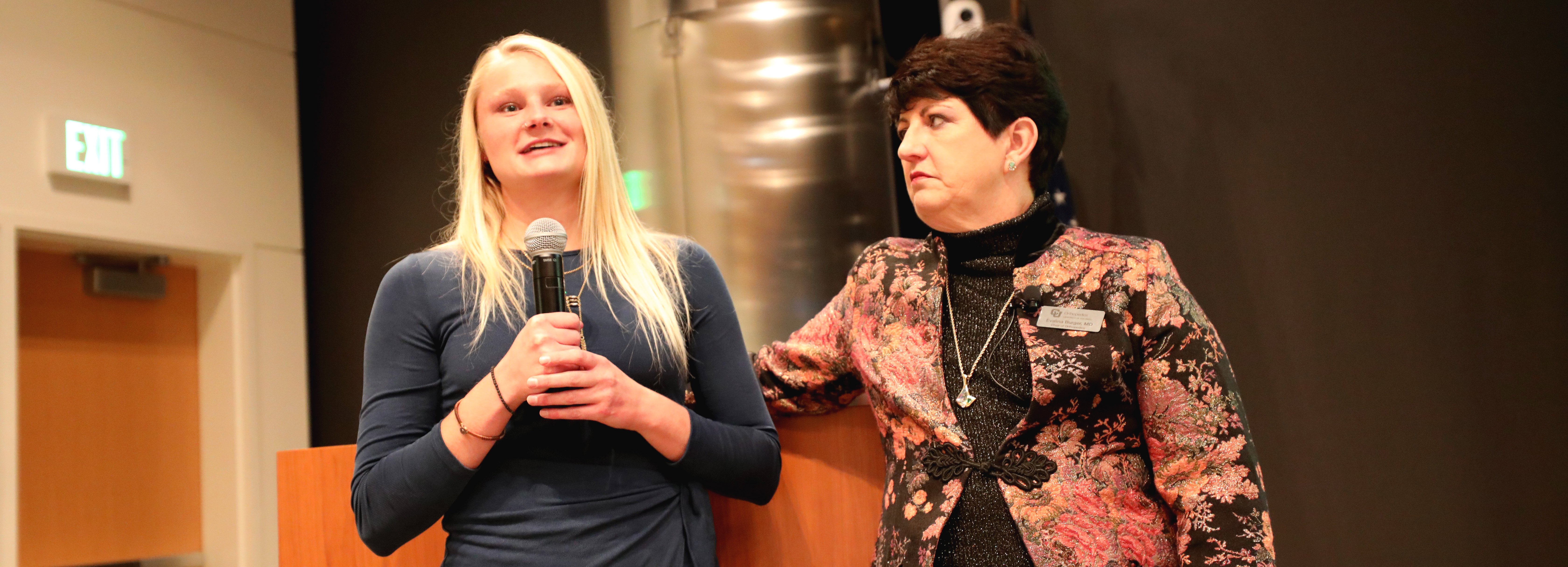For the orthopedics team at the CU Anschutz Medical Campus, simply meeting current standards of care is not sufficient.
At this week’s Transforming Health Care lecture, titled “Breakthroughs in Orthopedic Treatment and Care,” Chancellor Don Elliman said the orthopedics group at CU Anschutz is actively redefining what health care is going to look like in the future.
Over 100 people attended the event in the Krugman Conference Hall.
Speakers included Evalina Burger, MD, chair of the Department of Orthopedics in the School of Medicine; Jason Stoneback, MD, chief of Orthopedic Trauma and Fracture Surgery at UCHealth’s University of Colorado Hospital, vice chair for Clinical Affairs and associate professor for the Department of Orthopedics and director of the Limb Restoration Program at UCHealth; and Jason Dragoo, MD, professor and vice chair for Academic Affairs, Department of Orthopedics, Endowed Chair of Regenerative Medicine, director of the UCHealth Steadman Hawkins Clinic and head team orthopedic physician for the Denver Nuggets.
Moving from art to science
As a spine surgeon, Burger said orthopedics is at the cutting edge of keeping us young. Burger highlighted recent advances in imaging, such as that used to align spinal vertebrae during surgery, that have made a huge difference in patient outcomes like mobility. “Before it was an art; now it is a science.”

Maritza Wiedel explains how the disc replacement performed by spine surgeon Evalina Burger, MD, allowed her to resume her active athletic life.
Maritza Wiedel is an example of this science. A lifelong top athlete who played collegiate volleyball, lacrosse and skiing, Maritza began seeking orthopedics care at age 19 for intolerable lower back and buttock pain. Burger said that spinal pain is not uncommon in young elite athletes such as Maritza, as spines don’t stop growing until age 24.
Rather than performing a traditional disc fusion to immobilize the painful area of Maritza’s spine, Burger opted instead to perform a relatively new therapy called a disc replacement, where the damaged disc was removed through the abdomen followed by insertion of a synthetic disc. Disc replacement has better resulting mobility and a shorter healing time compared to traditional fusion.
Maritza attended Monday’s lecture, and in addition to tackling Mount Everest a year after her surgery, she said she ran an ultramarathon two weekends ago and is serving on ski patrol this winter. “After a year and half of constant pain, I was excited to start something new,” she said.
Redefining success
As a pioneer in regenerative medicine, it took Jason Dragoo six years of trial and error to discover the perfect cocktail of factors that would induce stem cells isolated from fat tissue to turn into cartilage. Using these cells, called progenitors, to repair joint damage, Dragoo said dramatic improvements in cartilage regeneration have been seen in clinical trials.
The first patient to receive the new minimally invasive surgical technique was David, in attendance at the lecture. At age 27, David is enjoying the best shape of his life, having recently completed an Ironman triathlon.
After a snowboarding fall resulted in David missing a piece of cartilage the size of a thumbnail under his kneecap, consultation with several doctors revealed a consensus that David’s injury would result in pain, early arthritis and eventually require a knee replacement.
“Basically they said, ‘Get some new hobbies and be on your way,’” David said.
When asked how he made the decision to be the very first recipient of Dragoo’s new surgical technique, David said it came down to his definition of success. “Just being able to walk was not enough for me,” he said. “I wasn’t really worried about the surgery; I was more worried about siting around the rest of my life not being able to use my legs.”
He added, “I’m glad I could help further medical science.”
Two years later, David has had no complications following his surgery and recently completed two legs of an Ironman triathlon. He said, “I wasn’t going to let my situation control my life.”
Game-changer for amputees
In the United States, 1.8 million people currently live with amputation, with one million who lost a limb or partial limb due to complications from diabetes or vascular disease. Beyond the staggering amount of time required to properly seat and secure a socket-style prosthesis, amputees have many other obstacles related to quality of life, including skin friction, poor prosthetic fit, and decreased confidence walking due to inability to feel the ground.
‘Osseointegration is a game-changer for amputees.’ – Jason Stoneback, MD, director of the Limb Restoration Program at UCHealth
Jason Stoneback is pioneering work to improve prostheses through a technique called osseointegration, where a porous metal weight-bearing rod, called a bone-anchored prosthesis (BAP), is inserted into bone. Living bone attaches, regrows, and fills in the gaps in the metal, resulting in a prosthesis that is more stable and significantly easier to easier to attach and secure. This would improve quality of life for some patients, including a 15-year-old patient of Stoneback’s, for whom the fear of a prosthesis falling off is sufficiently embarrassing so as to avoid many social situations entirely.
Osseointegration improves the ability to feel sensation through the prostheses, increases mobility and function, improves quality of life, and can potentially decrease pain at the amputation site and throughout the body.
Simply put, said Stoneback, “Osseointegration is a game-changer for amputees.”
Stoneback announced that his research group was starting clinical trials to make osseointegration more widely available in the United States, as it is currently restricted to use in amputees due to trauma, congenital defects, and tumor amputation. “We are grateful to be at the cutting edge of research on this campus.”
Guest contributor: Shawna Matthews, a CU postdoc



